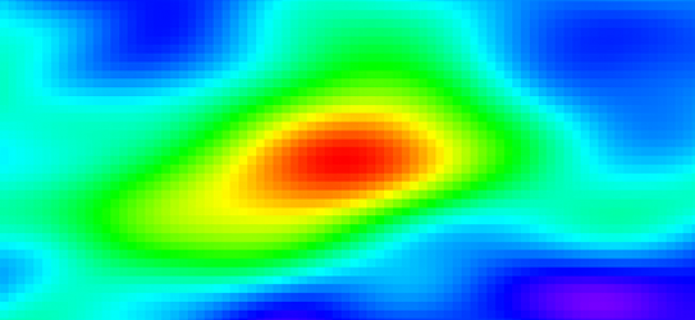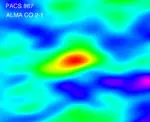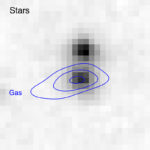ALMA telescope unveils rapid formation of new stars in distant galaxies
Galaxies forming stars at extreme rates nine billion years ago were more efficient than average galaxies today, researchers find.
The majority of galaxies are believed to lie on a “main sequence”, where the larger a galaxy’s mass, the higher its efficiency to form new stars. However, every now and then a galaxy will display a burst of newly formed stars that shine brighter than the rest. A collision between two large galaxies is usually the cause of such starburst phases, where the cold gas residing in the giant molecular clouds becomes the fuel for sustaining such high rates of star formation.
The question astronomers have been asking is whether such starbursts in the early Universe were the result of having an overabundant gas supply, or whether galaxies converted gas more efficiently.
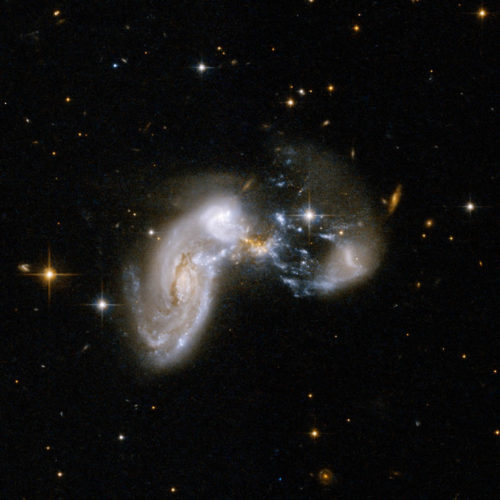
Photo of a colliding starburst galaxy taken by Hubble, as an example of such objects. Baby Boom was discovered by NASA's Spitzer Space Telescope, Hubble and several other telescopes.
A new study to be published in Astrophysical Journal letters on October 12, 2015, lead by John Silverman at the Kavli Institute for the Physics and Mathematics of the Universe [1], studied carbon monoxide (CO) gas content in seven starburst galaxies far away from when the Universe was a young four billion years old. This was feasible by the advent of Atacama Large Millimeter/submillimeter Array (ALMA), located at 5,000 meters altitude in northern Chile, which works in tandem to detect electromagnetic waves at a wavelength range in the millimeter (pivotal for studying molecular gas) and a sensitivity level that is just starting to be explored by astronomers today.

Map of the galaxy PACS-867 taken by ALMA where the emission from carbon monoxide (CO) shows the molecular gas reservoir out of which stars form
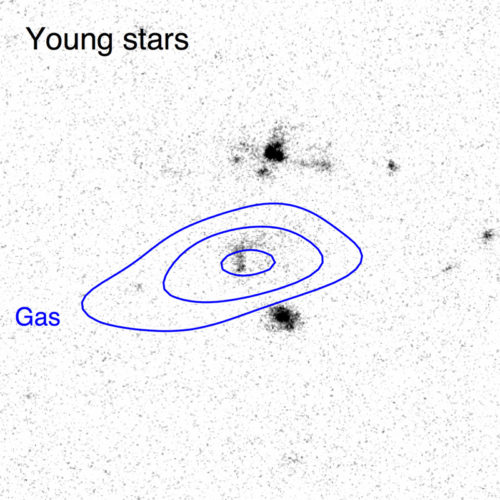
Image taken by the Hubble Space Telescope Advanced Camera for Surveys of PACS-867 that shows the rest-frame UV light from young stars in the individual components of highly disturbed galaxies as a result of a massive merger. The location of the molecular gas in Image 2 is overlaid (blue contours) that shows where new stars, enshrouded by dust, are forming

Spitzer Space Telescope infrared image (3.6 micron) of PACS-867 highlights the stars embedded in dust and associated with the molecular gas. The UV light associated with the gas is faint while it is brighter in the infrared. This is due to the presence of dust that impacts the UV more than the IR
“These observations clearly demonstrate ALMA’s unique capability to measure with ease a critical component of high redshift galaxies thus indicative of the remarkable results to come from ALMA,”Silverman said.
The researchers found the amount of CO-emitting gas was already diminished even though the galaxy continued to form stars at high rates. These observations are similar to those recorded for starburst galaxies near Earth today, but the amount of gas depletion was not quite as rapid as expected. This led researchers to conclude there might be a continuous increase in the efficiency depending on how high above the rate of forming stars is from the main sequence.
This study relied on a variety of powerful telescopes available through the COSMOS survey. Only the Spitzer and Herschel Observatories could measure accurate rates of star formation, and the Subaru Telescope could confirm the nature and distance of these extreme galaxies using spectroscopy.
More information
This observation result was published by Silverman et al. as “A higher efficiency of converting gas to stars pushes galaxies at z~1.6 well above the star-forming main sequence” in the Astrophysical Journal letters, issued in October 12, 2015.
- J. D. Silverman/ Kavli Institute for the Physics and Mathematics of the Universe (WPI), The University of Tokyo Insti- tutes for Advanced Study, The University of Tokyo, Kashiwa, Chiba 277-8583, Japan;
- E. Daddi/ Laboratoire AIM, CEA/DSM-CNRS-Universite Paris Diderot, Irfu/Service d’Astrophysique, CEA Saclay;
- G. Rodighiero/ Dipartimento di Fisica e Astronomia, Universita di Padova, vicolo Osservatorio, 3, 35122, Padova, Italy;
- W. Rujopakarn/ Kavli Institute for the Physics and Mathematics and Department of Physics, Faculty of Science, Chulalongkorn University, 254 Phayathai Road, Pathumwan, Bangkok 10330, Thailand;
- M. Sargent / Astronomy Centre, Department of Physics and Astronomy, University of Sussex, Brighton, BN1 9QH, UK;
- A. Renzini/ Instituto Nazionale de Astrofisica, Osservatorio Astronomico di Padova, v.co dell’Osservatorio 5, I-35122, Padova, Italy, EU;
- D. Liu / Laboratoire AIM, CEA/DSM-CNRS-Universite Paris Diderot, Irfu/Service d’Astrophysique, CEA Saclay;
- C. Feruglio / IRAM - Institut de RadioAstronomie Millim ́etrique, 300 rue de la Piscine, 38406 Saint Martin d’H`eres, France;
- D. Kashino/ Division of Particle and Astrophysical Science, Graduate School of Science, Nagoya University, Nagoya, 464-8602, Japan
- D. Sanders / Institute for Astronomy, University of Hawaii, 2680 Woddlawn Drive, Honolulu, HI, 96822;
- J. Kartaltepe (10), T. Nagao/ Graduate School of Science and Engineering, Ehime University, 2-5 Bunkyo-cho, Matsuyama 790-8577, Japan
- N. Arimoto/ Subaru Telescope, 650 North A’ohoku Place, Hilo, Hawaii, 96720, USA;
- S. Berta/ Max-Planck-Institut fu ̈r extraterrestrische Physik, D-84571 Garching, Germany;
- M. B ́ethermin / European Southern Observatory, Karl-Schwarzschild-Str. 2, 85748 Garching, Germany;
- A. Koekemoer / Space Telescope Science Institute, 3700 San Martin Drive, Baltimore, MD, 21218, USA;
- D. Lutz / Max-Planck-Institut fu ̈r extraterrestrische Physik, D-84571 Garching, Germany;
- G. Magdis / Department of Physics, University of Oxford, Keble Road, Oxford OX1 3RH, UK and Institute for Astronomy, Astrophysics, Space Applications and Remote Sensing, National Observatory of Athens, GR-15236 Athens, Greece;
- C. Mancini / Instituto Nazionale de Astrofisica, Osservatorio Astronomico di Padova, v.co dell’Osservatorio 5, I-35122, Padova, Italy, EU;
- M. Onodera/ Institute of Astronomy, ETH Zu ̈rich, CH-8093, Zu ̈rich, Switzerland
- G. Zamorani / INAF Osservatorio Astronomico di Bologna, via Ranzani 1, I-40127, Bologna, Italy
The Atacama Large Millimeter/submillimeter Array (ALMA), an international astronomy facility, is a partnership of the European Organisation for Astronomical Research in the Southern Hemisphere (ESO), the U.S. National Science Foundation (NSF) and the National Institutes of Natural Sciences (NINS) of Japan in cooperation with the Republic of Chile. ALMA is funded by ESO on behalf of its Member States, by NSF in cooperation with the National Research Council of Canada (NRC) and the Ministry of Science and Technology (MOST) in Taiwan and by NINS in cooperation with the Academia Sinica (AS) in Taiwan and the Korea Astronomy and Space Science Institute (KASI).
ALMA construction and operations are led by ESO on behalf of its Member States; by the National Radio Astronomy Observatory (NRAO), managed by Associated Universities, Inc. (AUI), on behalf of North America; and by the National Astronomical Observatory of Japan (NAOJ) on behalf of East Asia. The Joint ALMA Observatory (JAO) provides the unified leadership and management of the construction, commissioning and operation of ALMA.
Contacts:
John Silverman
Kavli Institute for the Physics and Mathematics of the Universe, The University of Tokyo
E-mail: [email protected]
Motoko Kakubayashi
Press office at the Kavli Institute for the Physics and Mathematics of the Universe, The University of Tokyo
T: +81-4-7136-5980 (office)
E-mail: [email protected]
Valeria Foncea
Education and Public Outreach Officer
Joint ALMA Observatory
Santiago, Chile
Tel: +56 2 467 6258
Cell: +56 9 75871963
E-mail: [email protected]
Masaaki Hiramatsu
Education and Public Outreach Officer, NAOJ Chile
Observatory
Tokyo, Japan
Tel: +81 422 34 3630
E-mail: [email protected]
Charles E. Blue
Public Information Officer
National Radio Astronomy Observatory
Charlottesville, Virginia, USA
Tel: +1 434 296 0314
Cell: +1 434.242.9559
E-mail: [email protected]
Richard Hook
Public Information Officer, ESO
Garching bei München, Germany
Tel: +49 89 3200 6655
Cell: +49 151 1537 3591
E-mail: [email protected]
